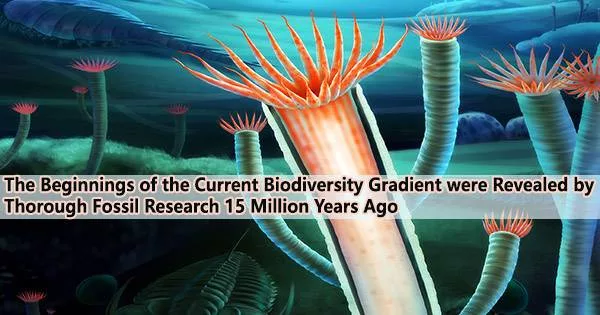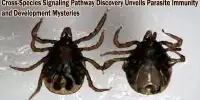In order to explain why the diversity of species is highest at the equator and slowly declines toward the poles, scientists have used roughly half a million fossils. The findings, which were released today in the journal Nature, provide important new understanding of how biodiversity develops over long time scales and how climate change may alter the diversity of species worldwide.
It is well known that species (including animals, plants, and single-celled creatures) exhibit a “latitudinal diversity gradient” in both marine and terrestrial systems, with biodiversity peaking around the equator. Yet, the lack of sufficient fossil material has hindered scholars from fully examining the origins of this diversity gradient.
In this new study, researchers at the Universities of Oxford, Leeds and Bristol, used a group of unicellular marine plankton called planktonic foraminifera. The team analyzed 434,113 entries in a global fossil database, covering the last 40 million years. After that, they looked into potential contributors to the latitudinal diversity gradient, such as sea surface temperatures and ocean salt levels, and the number of species through time and place.
Key findings:
- Around 34 million years ago, as the Earth started to change from a warmer to a colder environment, the contemporary latitudinal variety gradient first began to appear.
- This gradient initially remained shallow, until around 15–10 million years ago, when it steepened significantly. This coincides with a significant increase in global cooling.
- Peak richness for planktonic foraminifera occurred at higher latitudes from 40–20 million years ago. By around 18 million years ago, however, peak richness shifted to between 10° to 20° latitude, consistent with the diversity pattern observed today.
- When sea surface temperatures were modeled throughout time at particular sites or at many locations at a particular time, there was a significant positive correlation between species richness and sea surface temperatures.
- There was also a positive relationship between species richness and the strength of the thermocline: the temperature gradient that exists between the warmer mixed water at the ocean’s surface and the cooler deep water below.
Understanding why species in ancient history were more diverse and plentiful nearer the equator and less so nearer the poles can give important insights how marine species, such as plankton, might respond in future. These tiny single-celled organisms are a vital link in the marine food chain, so studying their reactions to changing climates may help us better predict how they will likely be affected as temperatures continue to warm with the increasing onset of climate change.
Dr. Alex Farnsworth
These findings, according to the researchers, suggest that the steepening of the latitudinal temperature gradient from the equator to the poles over the last 15 million years may be responsible for the modern-day distribution of species richness for planktonic foraminifera. In comparison to higher latitudes, this may have created more ecological niches in the water column in tropical areas, favoring higher rates of speciation.
The researchers to test this idea investigated the extent to which contemporary species of planktonic foraminifera dwell at various depths within the vertical water column. They discovered that, in comparison to high latitudes, species are now more equally distributed vertically within the water column in low latitudes around the equator.
This shows that a major increase in the difference in sea surface temperatures between low and high latitude regions, as well as within the water column, from 15 million years ago onwards, was a primary driver of the modern-day diversity gradient. The tropics’ warmer seas were able to support a wider variety of ecological niches and habitats with varying temperatures, which promoted the evolution of more species.
This is supported by the fact that the tropics today are richer than the tropics of warmer time periods in the past (such as the Eocene and Miocene) when there was little or no vertical temperature gradient in the oceans.
The contemporary diversity gradient was likely influenced by the extermination of numerous regional populations of species due to lowering water temperatures at high latitudes.
Planktonic foraminifera originate from the Early to Middle Jurassic period (around 170 million years ago). They inhabit a variety of biological niches in the upper two kilometers of the oceans and can be found in oceans all over the world, from the polar regions to the equator.
Because they produce hard outer shells, they can be preserved in large numbers. Planktonic foraminifera were a perfect candidate for this investigation due to their widespread abundance and remarkable fossil record from the past 66 million years.
Dr. Erin Saupe (Department of Earth Sciences, University of Oxford), lead author for the study, said, “By resolving how spatial patterns of biodiversity have varied through deep time, we provide valuable information crucial for understanding how biodiversity is generated and maintained over geological timescales, beyond the scope of modern-day ecological studies.”
Associate Professor Tracy Aze (School of Earth and Environment, University of Leeds), a co-author for the study, added, “Although they are small enough to fit on the head of a pin, planktonic foraminifera have one of the most complete species-level fossil records known to science. Our research builds on 60 years of deep-sea sample collection and the diligent counting and recording of hundreds of thousands of specimens by research scientists. It’s fantastic to be able to produce such important results about the drivers of species distributions through time and to do justice this wonderful fossil archive.”
Study co-author Dr. Alex Farnsworth, Senior Research Associate at the Department of Geographical Sciences, University of Bristol, said, “Understanding why species in ancient history were more diverse and plentiful nearer the equator and less so nearer the poles can give important insights how marine species, such as plankton, might respond in future. These tiny single-celled organisms are a vital link in the marine food chain, so studying their reactions to changing climates may help us better predict how they will likely be affected as temperatures continue to warm with the increasing onset of climate change.”
“This has potentially large implications for marine food webs, such as fish and aquatic mammals like seals and whales, and could be used to inform future measures to protect sea life and preserve biodiversity.”
















